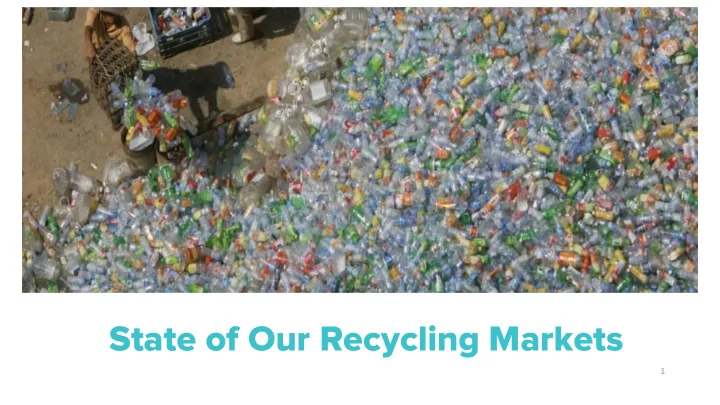

State of Our Recycling Markets 1
A Timeline of China’s Actions February 2013: China launches Green Fence • November 2015: China initiates stricter customs crackdown • February 2017: China announces National Sword • February-March 2017: China enforces National Sword via arrests • and confiscation of foreign scrap material April 2017: Ban on certain solid waste imports is brought to the • table April-July 2017: China steps up enforcement of National Sword • July 2017: China confirms its intent to ban certain recyclables from • import and announces plan for 0.3% contamination standard
A Timeline of China’s Actions August 2017: U.S. exporters report that Chinese buyers haven’t • received new import permits for recyclables since May October 2017: Some U.S. companies start landfilling materials due • to lack of end markets and decreasing commodity values November 2017: After pushback, China proposes (and later • agrees) to a slightly higher contamination standard of 0.5% January 2018: National Sword goes into effect and import permits • are issued to some Chinese importers February 2018: During earnings calls, solid waste companies share • the impact China’s regulations are having on them
A Timeline of China’s Actions March 2018: Contamination standard of 0.5% goes into effect • March 2018: China announces Blue Sky 2018 and both the U.S. • and China announce tariffs on certain products April 2018: China announces plans to ban additional materials and • U.S. solid waste companies discuss challenges at WasteExpo May 2018: CCIC shuts down for one month; China announces • regulatory changes; and Vietnam issues its own restrictions June 2018: Indonesia, Malaysia and Thailand also issue or consider • issuing restrictions; China addresses U.S. concerns
A Timeline of China’s Actions July 2018: Total ban of imports is proposed by China • August 2018: Tariff war between U.S. and China grows as China • targets recovered paper and plastic August 2018: Thailand announces plan to completely ban scrap • plastics imports within two years August 2018: Taiwan proposes its own restrictions; Recycling • markets continue to suffer; and U.S. solid waste companies share ongoing recycling challenges at WASTECON
China’s Regional Effects Waste Dive began tracking state-by-state effects in November • 2017, including queries to every agency. • Currently, characterize effects as “heavy” in 13 states, “noticeable” in 28 (plus D.C.) and “minimal” in 9. • Oregon first to receive major coverage, though eventually became clear this was affecting entire West Coast and Northeast most prominently. Has now spread nationwide in different ways. • Many program restrictions/cuts, but primarily just in small cities/towns.
Takeaways from Conferences/Earnings Calls Recycling is not dead! • Aside from China’s restrictions and recycling, labor, contamination • and safety top the list of challenges U.S. solid waste companies send little to no material to China in • the first half of 2018 compared to previous years Domestic infrastructure is underway and China’s restrictions could • actually present local opportunities • Companies express varying degrees of commitment to recycling, with underlying message that economics must be in their favor
Costs and Trends in Contract Changes
Costs and Trends in Contract Changes How high have we seen costs go in some states? • Who is affected by the cost changes? • What is considered a fair way to share the burden of risk? • From what you’ve heard, do you think these costs will eventually • decrease or continue to climb?
Technology Investments in MRFs
Technology Investments in MRFs What adjustments are MRF operators making in an effort to meet • China’s contamination standard of 0.5 percent? What types of technologies are they installing to make materials • cleaner? Role of AI? What about end markets? Can these investments help open the • doors to new opportunities?
Single Stream vs. Dual Stream
Single Stream vs. Dual Stream Since the implementation of China’s waste import restrictions, • how have single stream recycling programs changed? What are some of the challenges that come with single stream • recycling and how can they be avoided/overcome? Some municipalities are switching to dual stream. Why the • change?
Glass Recycling and the Bottle Bill
Glass Recycling and the Bottle Bill Does it still make sense to keep glass in the main stream? Who • supports this? How have governments and companies responded to market • challenges? What is being done by industry and government to promote glass • markets? Where in the U.S. have we seen recent bottle bill • expansions/successes?
Market Development
Market Development How far is too far to send material if the price is right? • Is the new Closed Loop Fund model working? • How can packaging companies get involved to boost market • demand, and what qualifies as a viable market?
Education and Communication Trends
Education and Communication Trends Are statewide standardized lists a way of the future? • Has Connecticut’s list been working? • How have education methods like “oops” tags, mailers, image • stickers, etc., been effective?
Other Topics and Trends
Other Topics and Trends What are some advantages and disadvantages of PAYT programs? • What’s the viability of state/local recycling goals and mandates? • Looking forward, what may the future have in store for the waste • and recycling industry?
Q&A
Contact Mallory Szczepanski Editorial Director of Waste360 Mallory.Szczepanski@informa.com; 212-204-4227 Cole Rosengren Senior Editor of Waste Dive crosengren@industrydive.com; 207-939-3101
Recommend
More recommend